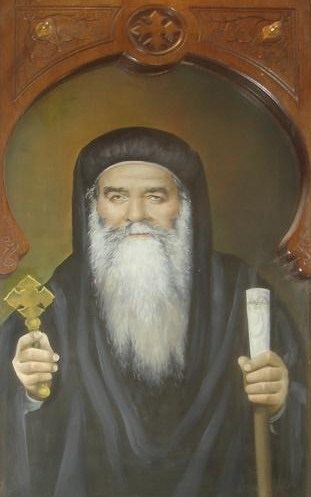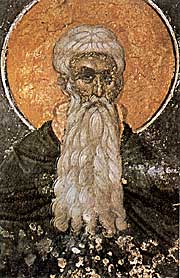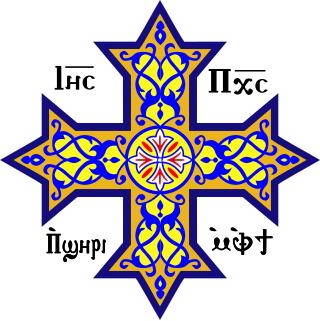This article needs additional citations for verification .(December 2012) |
This article needs additional citations for verification .(December 2012) |
Isaac was born in Dafra, near the modern city of Tanta. According to Coptic manuscripts, an angel encouraged him to travel to the town of Towa, near Beba in the Bani Suwayf Governorate, to profess that he is of Christian faith in front of the governor and to receive martyrdom. [1]
The governor had Isaac sent to his house under guard for torture, but while en route a blind man begged Isaac for help, whom he blessed and immediately the blind man could see. The guard moved Isaac onto the governors house, where upon arrival the guard admitted that he too now believed in Christ. The guard would be executed.
After being severely tortured Isaac was then sent to Oxyrhynchus for further torture and, eventually, execution. While being transported by boat Isaac begged a man with a blind and closed eye for water. Upon receiving the water he threw a few drops upon the blind man's closed eye, after which he could see again. [1]
After his arrival and further torture it is said that the inhabitants of the city of Behnesa came and begged for Isaac to be killed swiftly or released as many auspicious events had happened around his arrival. He was beheaded quickly. Some Christians returned Isaac's body to his town of Dafra, where a church was later built after him. Many miracles that happened around the church were attributed to him. [1]
The feast day of Saint Isaac of Defra is on 6 Pashons [2] in and around the month of May.

Pachomius, also known as Saint Pachomius the Great, is generally recognized as the founder of Christian cenobitic monasticism. Coptic churches celebrate his feast day on 9 May, and Eastern Orthodox and Catholic churches mark his feast on 15 May or 28 May. In Lutheranism, he is remembered as a renewer of the church, along with his contemporary, Anthony of Egypt on 17 January.

Pope Cyril VI of Alexandria also called Abba Kyrillos VI, Coptic: Ⲡⲁⲡⲁ Ⲁⲃⲃⲁ Ⲕⲩⲣⲓⲗⲗⲟⲥ ⲋ̅ ; was the 116th Pope of Alexandria and Patriarch of the See of St. Mark from 10 May 1959 to his death.

Saint Macarius of Alexandria was a monk in the Nitrian Desert. He was a slightly younger contemporary of Macarius of Egypt, and is thus also known as Macarius the Younger.

Saint Simon the Tanner, also known as Saint Simon the Shoemaker, is the Coptic Orthodox saint associated with the story of the moving the Mokattam Mountain in Cairo, Egypt, during the rule of the Muslim Fatimid Caliph al-Muizz Lideenillah (953–975) while Abraham the Syrian was the Pope of the Coptic Orthodox Church of Alexandria.
Samuel the Confessor is a Coptic Orthodox saint, venerated in all Oriental Orthodox Churches. He is most famous for his torture at the hands of the Chalcedonian Byzantines, for his witness of the Arab invasion of Egypt, and for having built the monastery that carries his name in Mount Qalamoun. He carries the label "confessor" because he endured torture for his Christian faith, but was not a martyr.
Pope Mark VII of Alexandria (Abba Marcos VII), 106th Pope of Alexandria & Patriarch of the See of St. Mark. Pope Mark VII was born in the city of Klosna, in the district of El Bahnasa, and his lay name was Simeon. He joined the Monastery of Saint Anthony at a young age, then moved to the Monastery of Saint Paul the Anchorite, where he became a monk and was ordained a priest. When Pope John XVII departed, he was chosen to succeed him. Pope Mark VII was ordained Pope and Patriarch of Alexandria on Sunday, 24 Pashons, 1461 A.M. (30 May 1745 AD) on the day of the feast of the entry of Christ to Egypt.

Arsenius the Deacon, sometimes known as Arsenius of Scetis and Turah, Arsenius the Roman or Arsenius the Great, was a Roman imperial tutor who became an anchorite in Egypt, one of the most highly regarded of the Desert Fathers, whose teachings were greatly influential on the development of asceticism and the contemplative life.

Marina, distinguished as Marina the Monk and also known as Marinos, Pelagia and Mary of Alexandria, was a Christian saint from part of Asian Byzantium, generally said to be present-day Lebanon. Details of the saint's life vary.
Master Malati or Moallem Malati is a Coptic Orthodox martyr and saint.
Otimus is a 3rd-century Egyptian martyr and saint. Otimus was born in Fowwa, and later became its priest. After some time, he moved to the mountain of Ansena. When Emperor Diocletian incited his persecution against the Christians, Arianus the governor of Ansena called for Otimus and ordered him to worship the idols. When Otimus refused, Arianus tortured him and eventually ordered him to be burned on 3 Pashons. The relics of Otimus are believed to be in the city of Kalabsha.
Saint John of Senhout is an Egyptian saint from the 4th century AD.
Epimachus of Pelusium was an Egyptian martyr.
Abāmūn of Tarnūt is a saint and was a martyr of the fourth-century Coptic Church. He is known only from his name being mentioned in the Synaxarion of Mikhail of Atrib (c.1240). His feast day is 3 August.

Saint Colluthus is a Coptic saint and martyr of the 3rd century AD said to be from Antinoöpolis.

Coptic history is the part of the history of Egypt that begins with the introduction of Christianity in Egypt in the 1st century AD during the Roman period, and covers the history of the Copts to the present day. Many of the historic items related to Coptic Christianity are on display in many museums around the world and a large number is in the Coptic Museum in Coptic Cairo.

Mercurius was a Roman soldier of Scythian descent who became a Christian saint and martyr. He was born in the city of Eskentos in Cappadocia, in Eastern Asia Minor. According to Christian tradition, he was the soldier who killed Julian the apostate during his campaign in Persia. Saint Mercurius was also widely known by his Arabic-language name Abu-Sayfain, Abu-Sifin or Abu-Sefein in Egyptian Arabic which means "father of two swords", referring to the second sword given to him by the Archangel Michael.

Abanoub or Abanob or Abanoub Al-Nahisy, is a 4th-century Christian saint and martyr from Egypt. His name is related to the Egyptian god Anoubis. He was born in Nehisa in the Nile Delta to Christian parents. Abanoub was 12 years old when he was killed and beheaded, after being tortured for refusing to leave Christianity. His feast day is July 31. His relics are preserved in St. Virgin Mary and St. Abanoub Churches in Sebennytos, Egypt. His title is often The Child Martyr.

Abaskhiron the Soldier or Eskhayron the Soldier is a Coptic martyr and saint. The name "Abaskhyron" is derived from two words, The honorific title "Abba" which means father, is given to him out of respect. The second part of the name, "skhyron", sometimes "eshseros", "eskaros", means the strong.

Monastery of Saint Samuel the Confessor, Dair al-Anba Ṣamū'īl al-mu'tarif " or Deir el-Qalamun is an Egyptian monastery in the Western Desert.
Saint Arianus was a historically attested governor of Ansena in Egypt and a notable figure in the Diocletianic persecution. He is a recurring character in Coptic hagiography, wherein he often attempts to torture Christian martyrs into worshiping idols, gets frustrated with their resilience and has them beheaded. In these hagiographies he is depicted with a sadistic fondness for torture, employing various methods such as beating, combing, nailing, burning, imprisoning, crucifying, and spearing Christians.